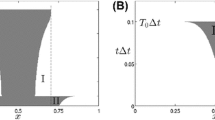Abstract
We study the optimal stopping problem proposed by Dupuis and Wang (Adv. Appl. Probab. 34:141–157, 2002). In this maximization problem of the expected present value of the exercise payoff, the underlying dynamics follow a linear diffusion. The decision maker is not allowed to stop at any time she chooses but rather on the jump times of an independent Poisson process. Dupuis and Wang (Adv. Appl. Probab. 34:141–157, 2002), solve this problem in the case where the underlying is a geometric Brownian motion and the payoff function is of American call option type. In the current study, we propose a mild set of conditions (covering the setup of Dupuis and Wang in Adv. Appl. Probab. 34:141–157, 2002) on both the underlying and the payoff and build and use a Markovian apparatus based on the Bellman principle of optimality to solve the problem under these conditions. We also discuss the interpretation of this model as optimal timing of an irreversible investment decision under an exogenous information constraint.





Similar content being viewed by others
References
Abramowitz, M., Stegun, I.: Handbook of Mathematical Functions. Dover, New York (1968)
Alvarez, L.H.R.: Reward functionals, salvage values and optimal stopping. Math. Methods Oper. Res. 54(2), 315–337 (2001)
Alvarez, L.H.R., Stenbacka, R.: Adoption of uncertain multi-stage technology projects: a real options approach. J. Math. Econ. 35, 71–97 (2001)
Alvarez, L.H.R., Stenbacka, R.: Takeover timing, implementation uncertainty, and embedded disinvestment options. Rev. Finance 10, 417–441 (2006)
Borodin, A., Salminen, P.: Handbook on Brownian Motion—Facts and Formulæ. Birkhäuser, Basel (2002)
Boyarchenko, S., Levendorskiĭ, S.: Exit problems in regime-switching models. J. Math. Econ. 44, 180–206 (2008)
Cox, A.M.G., Hobson, D.G.: Local martingales, bubbles and option prices. Finance Stoch. 9, 477–492 (2005)
Dayanik, S., Karatzas, I.: On the optimal stopping problem for one-dimensional diffusions. Stoch. Process. Appl. 107(2), 173–212 (2003)
Dixit, A., Pindyck, R.: Investment Under Uncertainty. Princeton University Press, Princeton (1994)
Dupuis, P., Wang, H.: Optimal stopping with random intervention times. Adv. Appl. Probab. 34, 141–157 (2002)
Dynkin, E.: Markov Processes I. Springer, Berlin (1965)
Guo, X.: An explicit solution to an optimal stopping problem with regime switching. J. Appl. Probab. 38, 464–481 (2001)
Guo, X., Liu, J.: Stopping at the maximum of geometric Brownian motion when signals are received. J. Appl. Probab. 42, 826–838 (2005)
Guo, X., Miao, J., Morellec, E.: Irreversible investment with regime shift. J. Econ. Theory 122, 37–59 (2005)
Jeanblanc, M., Yor, M., Chesney, M.: Mathematical Methods for Financial Markets. Springer, London (2009)
Jiang, Z., Pistorius, M.R.: On perpetual American put valuation and first-passage in a Regime-Switching model with jumps. Finance Stoch. 12, 331–355 (2008)
Johnson, T.C.: The optimal timing of investment decisions. Ph.D. Thesis, King’s College, London (2006)
Lempa, J.: A note on optimal stopping of diffusions with a two-sided optimal rule. Oper. Res. Lett. 38, 11–16 (2010)
Øksendal, B.: Stochastic Differential Equations, 5th edn. Springer, Berlin (2000)
Peskir, G., Shiryaev, A.: Optimal Stopping and Free Boundary Problems. Birkhäuser, Basel (2006)
Rogers, L.C.G., Williams, D.: Diffusions, Markov Processes and Martingales, vol. 1. Cambridge University Press, Cambridge (2001)
Rogers, L.C.G., Zane, O.: A simple model of liquidity effects. In: Advances in Finance and Stochastics: Essays in Honour of Dieter Sondermann, pp. 161–176. Springer, Berlin (2002)
Salminen, P.: Optimal stopping of one-dimensional diffusions. Mat. Nachr. 124, 85–101 (1985)
Shepp, L., Shiryaev, A.: The Russian option: reduced regret. Ann. Appl. Probab. 3, 631–640 (1993)
Shiryaev, A.: Probability, 2nd edn. Springer, Berlin (1996)
Acknowledgements
An anonymous referee is gratefully acknowledged for careful reading and for a number of very helpful comments. The author thanks Prof. Luis H.R. Alvarez, Prof. Fred Espen Benth, Dr. Paul C. Kettler, Prof. Andreas E. Kyprianou and Prof. Paavo Salminen for discussions and comments on earlier versions of this paper. Financial support from Research Foundation of OP-Pohjola group and the project “Electricity markets: modelling, optimization and simulation (EMMOS)” funded by the Norwegian Research Council under grant 205328/v30 is acknowledged. Prof. Esko Valkeila and Department of Mathematics and System Analysis in Aalto University School of Science and Technology are acknowledged for hospitality.
Author information
Authors and Affiliations
Corresponding author
Rights and permissions
About this article
Cite this article
Lempa, J. Optimal Stopping with Information Constraint. Appl Math Optim 66, 147–173 (2012). https://doi.org/10.1007/s00245-012-9166-0
Published:
Issue Date:
DOI: https://doi.org/10.1007/s00245-012-9166-0




